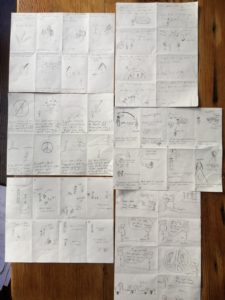 This a Story Listening variation on Dictation, originally posted on the facebook groups “CI Liftoff” and “Teaching Latin for Acquisition”
This a Story Listening variation on Dictation, originally posted on the facebook groups “CI Liftoff” and “Teaching Latin for Acquisition”
Had a great story listening experience with my Latin 1’s this past week. I took a 16 sentence dictation story (super simple embedded) from previous years, but instead of doing the dictation ( Ben Slavic-style) I asked students to fold a blank sheet into 8 sections, and during each sentence they were to draw something and write any word(s) (in either language) that describes the episode. Then I started, reading aloud and showing the sentences, slowly sometimes repeating myself, sometimes translating words, sometimes not. Some kids wrote down whole sentences, some kids wrote one word, some kids did quick sketches, some kids asked to take the paper home and perfect it overnight. What they all had in common was that they were all listening, understanding and engaging with the story in exactly the right way for each of them. I did 8 sentences the first day, and 8 sentences the next day, and at the end we had some beautiful and compelling data demonstrating comprehension and creativity on up the levels of Blooms taxonomy, without one bit of explicit skill building.
related activities from other teachers:
P.s. In the comment thread, Beniko Mason Nanki (http://www.benikomason.net) provided this description of what Story Listening is, and how it promotes acquisition: “SL is like this: 1) Theory-based. Thus, massive amount of auditory CI; 2) no time wasted. students hear the language they understand during the class all the time without interruption; 3) No threatening environment for any students, as they do not participate verbally. They are fully participating mentally, emotionally, and spiritually; 4) Research-based. There is enough evidence that SL works. The rate of vocabulary acquisition is from .1 to .25 words per minute which is close to native speaker children’s vocabulary acquisition rate; 5) Students do not have to spend money for a text book; 6) It is easy to prepare for a lesson; 7) non-native speaker teachers can get to improve their foreign language proficiency by telling stories to kids every day, all day, every week, every month, every year!! 8) Students competency improves. They can not help but get better. 9) Unlike reading it is easier to listen than to read letters. We have a captive audience. They know that they can get good grades if they listen, so they will listen when you tell a story. When the story is interesting, they don’t know that they are studying. They are just enjoying the story. 10) you don’t need to do any test or any review or anything, It is easy on teachers too. All you have to do is to give them massive amount of CI in SL. Everyday you just tell them a story. Scary stories, Cruel stories, Stupid stories, Love stories, Cunning Stories, Hero stories. I have about 300 stories that I can choose according to the students interests and levels. The SL book will explain my errors and how this SL evolved to the NT (non-targeted) from very skill-based. I wrote this book because I do not want you to go through the error that I did, but when I started SL, no one was doing it and there was no research. Now I can tell you that it is SAFE to use SL. Remember, Dr. Stephen Krashen is the champion of SL. I did not invent it. HE did!! Remember his earlier presentation of “Das ist meine Hand!”?? I took it and developed it so that we can use SL method from the very beginning level to all the way to the advanced level!!”
